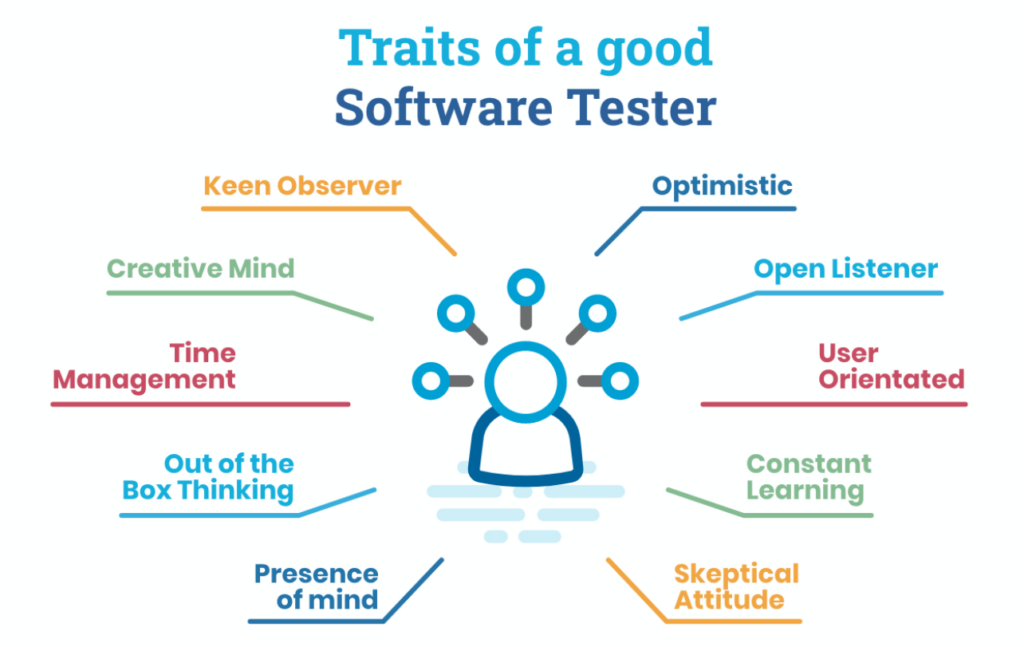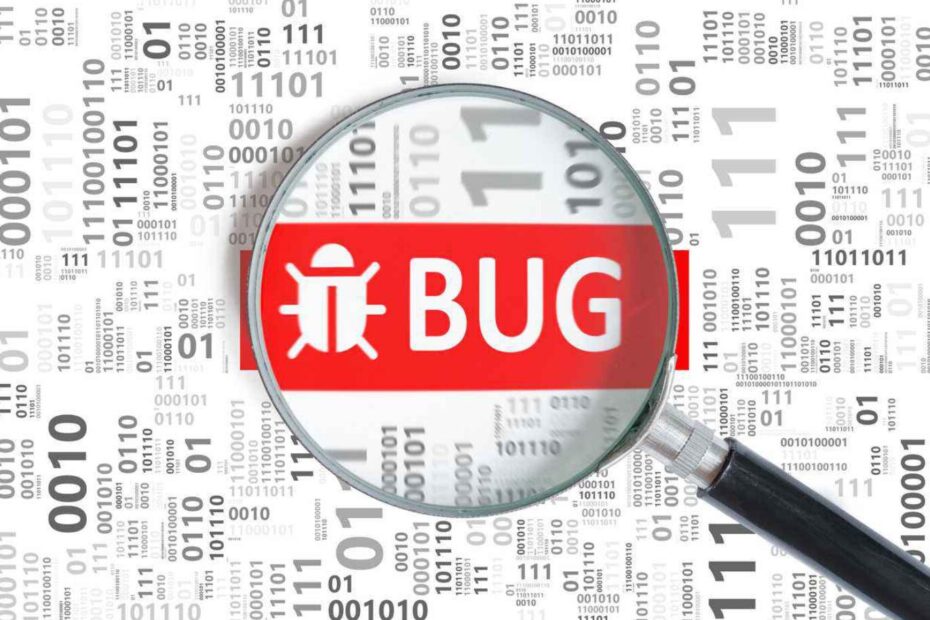Software Testers
Software testers are responsible for checking that software applications are functional, reliable, and meet the user’s needs. They use various techniques, such as manual testing, automation testing, or performance testing, to identify defects and improve software quality. Another essential attribution of a tester is to provide constructive feedback, so that it can improve the quality of the software they test.
A software testing role also involves working in collaboration with multiple stakeholders including developers, project support teams and system users to understand the scope of the project. A software tester troubleshoots, writes bug reports, provides feedback to developers, and also communicates test outcomes with both technical and non-technical stakeholders.
Software testers often analyses how the application should work before the code is even written. They ask questions like “what if the user does this” or “what if I enter a negative value? What happens?” These are just two examples of questions. They can multiply infinitely. The software tester’s job is to anticipate as many potential scenarios for using the application as possible. Eliminating bugs at the very beginning of our development process is cheaper than fixing them at a later stage.
testers pay attention to the fact that the navigation should be intuitive and not misleading. Often at this point, the tester’s job also involves making suggestions for improvements to the app. Then, after the developers have created the app, the software testers proceed to test it. At this point, the tester’s job is to verify that the ordered app works according to the requirements. The tester has to make sure that the system does exactly what it is supposed to do and that it works fast enough to fulfil its function. Additionally, it has to be checked if the app is intuitive, easy to use and its visual part is good in perception.
How To Become A Software Tester
Becoming a software tester is a strategic career path that involves understanding both the technical and business aspects of software development. Software testing is crucial for ensuring the quality, reliability, and performance of software before it reaches end users.
1. Understand the Basics of Software Development
- Learn Programming Fundamentals: Familiarize yourself with basic programming concepts and languages like Python, Java, or C#. Even if testing does not always require in depth programming knowledge, understanding how software is built helps in designing tests and communicating with developers.
- Study Software Development Life Cycle (SDLC): Get to know different software development methodologies, such as Agile, Waterfall, and DevOps. Understanding the SDLC will help you appreciate where testing fits into the broader context of software development.
2. Gain Knowledge in Software Testing
- Learn Testing Fundamentals: Understand different types of testing (e.g., unit, integration, system, acceptance) and the principles behind them. Books, online courses, and tutorials can be great resources.
- Get Familiar with Testing Tools: Explore tools used in software testing, such as Selenium for web application testing, JIRA for bug tracking, and Postman for API testing. Hands-on experience with these tools will be invaluable.
3. Build Practical Experience
- Start Small: You can begin by testing software that you use daily or by contributing to open source projects. This provides practical experience and helps build your portfolio.
- Create Your Own Projects: Developing your own small applications or automating daily tasks provides a dual benefit of learning to code and testing your work, reinforcing your understanding of both development and testing.
4. Earn a Degree or Certification
- Pursue Relevant Education: While not always required, a degree in computer science, IT, or a related field can provide a strong foundation.
- Consider Certification: Certifications like ISTQB (International Software Testing Qualifications Board) and CSTE (Certified Software Tester) can demonstrate your commitment and knowledge to potential employers.
- Online Courses: There are several online courses (on Udemy, LinkedIn Learning, Pluralsight, YouTube, Coursera) and training programs available that cover various aspects of software testing. These courses are typically self paced and can be accessed from anywhere, making them a convenient option for those who cannot attend traditional classes.
- On the Job Training: Many companies offer on the job training for software testers. This type of training allows you to gain practical experience and learn from experienced testers in a real world setting. Some companies may also provide mentorship programs, where you can work closely with a more experienced tester to develop your skills.

5. Develop Soft Skills
software testers must have technical and soft skills to be successful in their careers. Technical skills include knowledge of programming languages, operating systems, networking and testing tools. Soft skills such as communication, problem-solving, and attention to detail are also critical to software testing.
- Analytical Skills: Good testers have the ability to analyze complex systems, understand business requirements, and identify potential issues.
- Communication Skills: Effective communication is crucial for documenting findings, explaining issues to team members, and collaborating with developers.
- Attention to Detail: The ability to spot inconsistencies and minor errors can make a significant difference in the quality of the software.
Learn Programming Languages, start with one: Understanding programming languages like Java, Python, or C# can help you write automated tests and analyze test results. Start by learning the basics of these languages and practice coding to develop your skills.
Practice Test Automation: Test automation is an essential skill in software testing. Practice developing automated tests using tools like Selenium or Appium. This will help you develop skills in scripting, test automation frameworks, and test automation strategies.
Learn About APIs: APIs are a crucial component of modern software applications. Learn how to test APIs using tools like Postman or SoapUI. This will help you understand the technical aspects of software development and how testing fits into the process.
Understand Databases: Databases are used to store and retrieve data in software applications. Learn how to write SQL queries and understand how to test data integrity, security, and performance.
Seek Feedback: Seek feedback from your peers or colleagues to identify areas for improvement. This will help you identify areas where you need to focus your efforts and continue to develop your technical skills.
6. Stay Updated and Network
- Keep Learning: Software testing is a constantly evolving field, and it’s essential to stay up to date with the latest trends and technologies. Subscribe to industry publications and blogs, attend webinars and conferences, and participate in online forums to stay informed about emerging trends and best practices in software testing.
- Network: Joining communities, attending meetups, and participating in conferences can help you connect with other professionals, learn from their experiences, and find job opportunities.
7. Apply for Jobs and Prepare for Interviews
- Tailor Your Resume: Highlight your relevant skills, projects, and any experience that showcases your testing abilities.
- Prepare for Interviews: Be ready to discuss your testing philosophy, how you approach different testing scenarios, and be prepared to demonstrate your problem solving skills.
To Succeed As A Software Tester
you must be open to learning and growth. The field of software testing is constantly changing, and the most successful testers are those who are adaptable and willing to learn. Look for opportunities to develop new skills and take on new challenges and be open to feedback and constructive criticism.
Traits Of A Good Software Tester

Enozom is a dynamic software development company based in Alexandria, Egypt. Specializing in providing cloud enabled software applications, custom software solutions, and mobile applications, The company prides itself on delivering high quality software products that meet customer requirements, environmental factors, and constraints, leveraging the latest technologies in its development processes. With a focus on web development, web design, mobile app development, and software testing, Enozom is known for its commitment to building reliable solutions and establishing long term relationships with its clients from various countries, including the UK, USA, Germany, Egypt, and KSA.
Why Become A Software Tester
Get Creative
you have to get innovative when testing a software application. A good software tester has to think like a customer and understand any possible pain points they may have whilst using the software. This involves studying the latest trends, analyzing different stages of the software and then presenting the findings to the developers to improve the overall quality of the product.
Constant Learning
In a software testing role, no two days are the same. As the buffer between the user and a new product, you have the chance to use and test the latest tech before anybody else. You could be testing software for websites, mobile apps or content management systems. This presents a constant and ongoing opportunity to learn.
Various Pathways
Almost every sector that uses software needs software testing. From banking to retail, testers are deployed across multiple industries and in varied roles. You can choose from manual testing, performance testing, automated testing, providing several pathway options.
It’s Challenging
If you’re someone who enjoys a challenge and solving complex problems, a career in software testing might be just the thing for you. Each new software is different and poses different issues. This requires looking at products from different angles and adopting a new approach to testing each time.
Goals Of A Software Test
The goals of software testing are multifaceted and critical to the overall success of software development. Testing is not just about finding bugs, it encompasses a broader scope aimed at ensuring the software meets its requirements and provides a quality user experience.
1. Verify and Validate
- Verification: Ensures the product is developed correctly according to the design specifications.
- Validation: Ensures the product meets the user’s needs and requirements.
2. Ensure Quality
The primary goal of testing is to ensure the software’s quality. This includes its usability, reliability, performance, and security. Quality software not only meets its functional requirements but also provides a satisfactory user experience.
3. Detect Defects
Identifying bugs and defects before the software reaches the end user is a core objective. This process involves executing the software under controlled conditions and checking if it behaves as expected. Finding defects early in the development cycle can significantly reduce the cost and time to fix them.
4. Reduce Risks
Testing helps to mitigate risks associated with software failure. By identifying potential issues early, testing can prevent bugs that might cause data loss, security breaches, or system outages, thereby reducing the risk of financial loss and damage to the brand’s reputation.
5. Compliance with Requirements
Ensuring that the software complies with regulatory standards and industry specific requirements is essential, especially for applications in areas like healthcare, finance, and aviation. Compliance helps in avoiding legal penalties and ensuring the software is safe and reliable.
6. Support Decision Making
Testing provides stakeholders with information about the software’s quality and risks associated with its deployment. This information is crucial for making informed decisions regarding the software’s release readiness and understanding any limitations it may have.
7. Enhance User Satisfaction
By ensuring the software is bug free, easy to use, and performs well under various conditions, testing aims to enhance overall user satisfaction. Satisfied users are more likely to trust and remain loyal to the software.
8. Facilitate Continuous Improvement
The feedback loop from testing into the development process allows teams to continuously improve the software. Testing can uncover areas of improvement not only in the application itself but also in the development and testing processes.
9. Support Product Evolution
As software evolves with new features and updates, testing ensures that modifications do not adversely affect the existing functionality. Regression testing, for example, checks that new code changes do not introduce new defects into existing features.
Types of software testing
There are many types of software testing, but the two main categories are dynamic testing and static testing.
Dynamic testing is an assessment that’s conducted while the program is executed; static testing examines the program’s code and associated documentation. Dynamic and static methods are often used together.
The Main Types Of Software Testing Methodologies:
- Integration testing. This groups together two or more modules of an application to ensure they function collectively. This type of testing also reveals interface, communication and data flow defects between modules.
- Unit testing. Typically conducted during the application development phase, the purpose of unit testing is to ensure that each individual unit or component performs as expected. This is a type of white box testing and test automation tools.
- Functional testing. This entails checking functions against functional requirements. A common way to conduct functional testing is by using the black box testing
- Security testing. This ensures the software is free of potential vulnerabilities, known flaws and security loopholes that might affect the user system and data. Security testing is generally conducted through penetration testing.
- Performance testing. This tests the performance and speed of an application under a given workload.
- Regression testing. This verifies whether adding new features causes a decline in the functionality of an application.
- Stress testing. This assesses the strength of software by testing how much load it can take before reaching a breaking point. This is a type of nonfunctional test.
- Acceptance testing. This evaluates the entire system against the desired requirements and ensures the project is complete.
Software Tester Duties
- analyzing users’ stories and/or use cases/requirements for validity and feasibility
- collaborate closely with other team members and departments
- execute all levels of testing (System, Integration, and Regression)
- Design and develop automation scripts when needed
- Detect and track software defects and inconsistencies
- Provide timely solutions
- Apply quality engineering principles throughout the Agile product lifecycle
- Provide support and documentation
Conclusion
Software testers play a critical role in the development lifecycle, ensuring the reliability, functionality, and quality of software products. Identify bugs and inconsistencies, assess the software’s performance, and validate that it meets all requirements and specifications.
Beyond just finding errors, testers contribute to improving user experience, enhancing security, and ensuring the software behaves as expected under various conditions.
